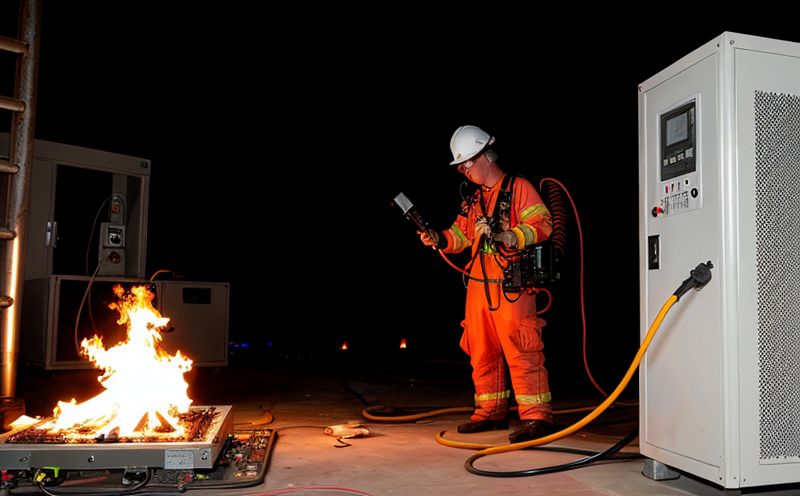Fire Resistance Testing for Electrical Transformers
The fire resistance testing of electrical transformers is a critical procedure that ensures safety and compliance in an increasingly complex electrical infrastructure. This test is essential to prevent fires, explosions, and subsequent damage or accidents caused by overheating or short circuits within the transformer components.
Electrical transformers are integral parts of power distribution systems, converting voltage levels for efficient transmission over long distances. Their design involves a variety of materials including insulation, copper windings, and cooling fluids. The fire resistance test evaluates how effectively these components can withstand ignition sources without failing catastrophically. This is particularly important in industrial settings where the failure of a transformer could lead to major disruptions or even catastrophic failures.
The testing process involves subjecting the transformer specimen to specified heat and flame exposure conditions. These tests follow international standards such as ASTM E2019, which ensures that the procedure is consistent with global practices. The test aims to assess the transformer's ability to retain its integrity under fire exposure, preventing electrical arcs or sparks from igniting surrounding materials.
During testing, careful preparation of the specimen is crucial. This includes cleaning and drying the transformer as per standards, ensuring no foreign substances interfere with the test results. Once prepared, the transformer is positioned in a test chamber where it is exposed to controlled flame conditions for specific durations. The duration may vary depending on the type of transformer and the intensity of the fire exposure.
The outcome of this testing provides valuable insights into the thermal stability and structural integrity of transformers. It helps manufacturers identify potential weaknesses, optimize designs, and improve safety features in their products. Compliance with these tests is not just a regulatory requirement but also an essential step towards enhancing public safety and minimizing risks associated with electrical equipment.
For quality managers and compliance officers, fire resistance testing ensures that all electrical transformers meet industry standards and regulations. R&D engineers can leverage the results to innovate safer designs, while procurement teams can use this information to select reliable suppliers who adhere to these stringent tests.
Why It Matters
The importance of fire resistance testing for electrical transformers cannot be overstated in today's highly interconnected and energy-intensive world. Electrical systems are integral to modern infrastructure, serving a wide range of critical applications from industrial manufacturing to residential lighting. Any failure within these systems can lead to significant disruptions or even catastrophic events.
- Prevention of Fires: Fire resistance testing ensures that transformers do not ignite under extreme conditions and prevent the spread of fire through electrical arcs.
- Enhanced Safety: By adhering to stringent testing protocols, manufacturers can enhance public safety by ensuring reliable performance during emergencies.
In addition to these direct benefits, successful completion of fire resistance tests also enhances a manufacturer's reputation and market competitiveness. It assures end-users that the product is robust and capable of withstanding harsh environmental conditions without compromising on quality or reliability.
Why Choose This Test
- Regulatory Compliance: Adhering to fire resistance testing ensures compliance with relevant international standards like ASTM E2019, thereby avoiding potential legal and financial penalties.
- Improved Safety: By demonstrating the transformer's ability to withstand fire exposure without failure, this test enhances public safety.
- Increased Reliability: The rigorous nature of these tests ensures that transformers perform reliably under extreme conditions, leading to fewer maintenance issues and extended service life.
In addition to these advantages, choosing fire resistance testing also demonstrates a commitment to quality and innovation. It allows manufacturers to stay ahead in the competitive market by offering safer and more reliable products.
Environmental and Sustainability Contributions
The fire resistance testing of electrical transformers plays a crucial role in promoting environmental sustainability. By ensuring that transformers can withstand extreme conditions without failure, these tests help reduce the risk of fires and subsequent pollution caused by equipment damage or failure. This not only minimizes the need for frequent replacements but also reduces the overall carbon footprint associated with manufacturing and disposing of obsolete products.
Moreover, fire resistance testing contributes to the sustainable use of materials. By optimizing transformer designs based on test results, manufacturers can reduce material waste and improve resource efficiency. The use of recyclable or less harmful materials in transformers that pass these tests also supports environmental sustainability goals.
- Eco-Friendly Materials: Using recycled metals and other sustainable materials reduces the demand for raw resources.
- Energy Efficiency: Reliable transformers contribute to energy efficiency, reducing overall electricity consumption and associated emissions.
In summary, fire resistance testing is an indispensable part of ensuring environmental sustainability by promoting safe and reliable electrical equipment that minimizes risks and supports sustainable practices.





